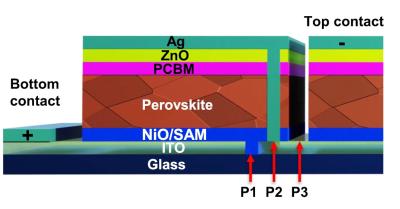Researchers from South Korea's Jeonbuk National University examined the use of slot die coating (SDC) to make uniform high-quality perovskite films as a step towards large-area perovskite device manufacturing.
Schematic illustration of the perovskite lab cell-sized module. Image credit: Communications Materials
The team found that SDC increased the roughness of the hole transport layer (HTL) interface, which improved the wettability of the surface, enabling a high-quality perovskite film without bubbles or pinholes. A perovskite solar cell based on the film achieved 19.17% efficiency with “excellent” stability results, and a lab cell-sized module achieved 17.42% efficiency.
Self-assembled monolayer (SAM), such as Me-4PACz, are excellent materials for the HTL in perovskite solar cells, noted the researchers, but they have poor wettability, which has delayed progress so far. To find a solution, the team analyzed a nickel oxide (NiOx) and Me-4PACz combination. They found that the use of SDC improved the roughness of the HTL interface, resulting in improved wettability.
They explained that the SDC-based NiOx/Me-4PACz hole transport layer suppressed energy losses at the HTL/perovskite interface.
“Applying a simple SDC process to coat NiOx/Me-4PACz HTL allowed the formation of a uniform, high-quality perovskite layer without pinholes, and furthermore, the SDC-based NiOx/Me-4PACz HTL suppressed energy losses at the HTL/perovskite interface,” said the researchers. “Furthermore, charge carrier dynamics analysis showed that SDC NiO/SDCMe-4PACz HTL improved hole extraction and transport at the interface of the perovskite layer.”
They also stressed that the 19.17% efficiency achieved by the device is higher compared to SDC NiO devices which had 15.87%, and said that the unencapsulated devices exhibited “excellent stability,” maintaining over 85% of their initial efficiency for more than 2,000 hours in a nitrogen atmosphere.
“Our findings suggest that the SDC process not only effectively eliminates the limitations associated with Me-4PACz, but also provides a promising approach for the sustained mass production of PSCs, which could lead to the fabrication of highly efficient perovskite solar modules and pave the way for future commercialization,” concluded the team.




